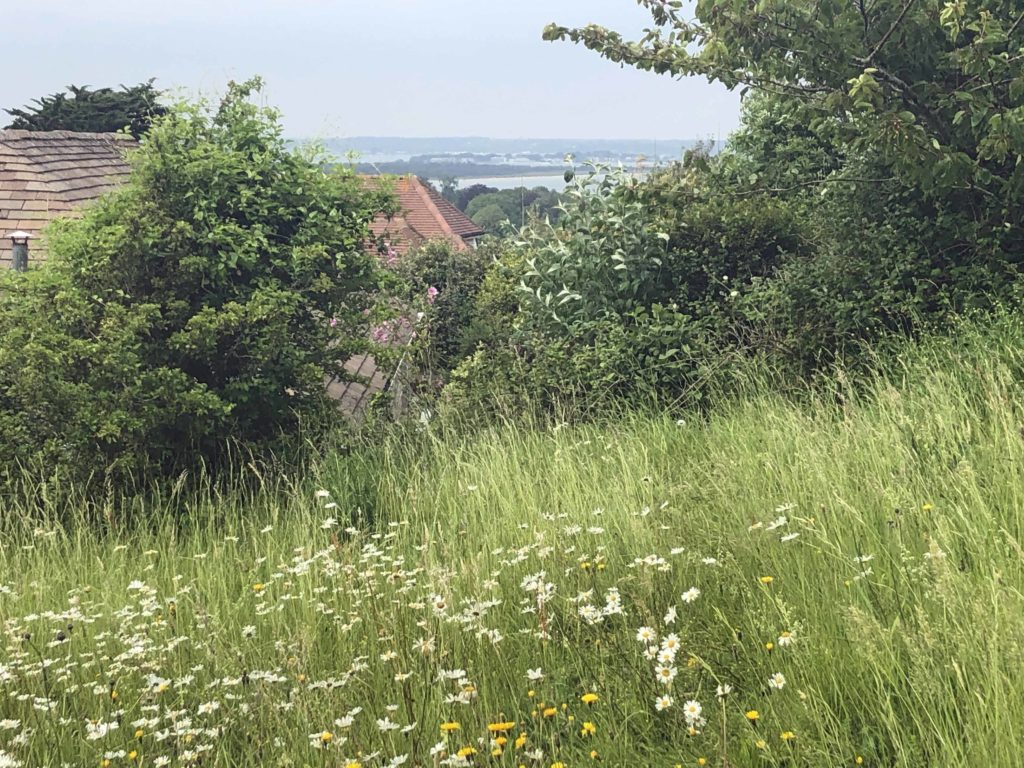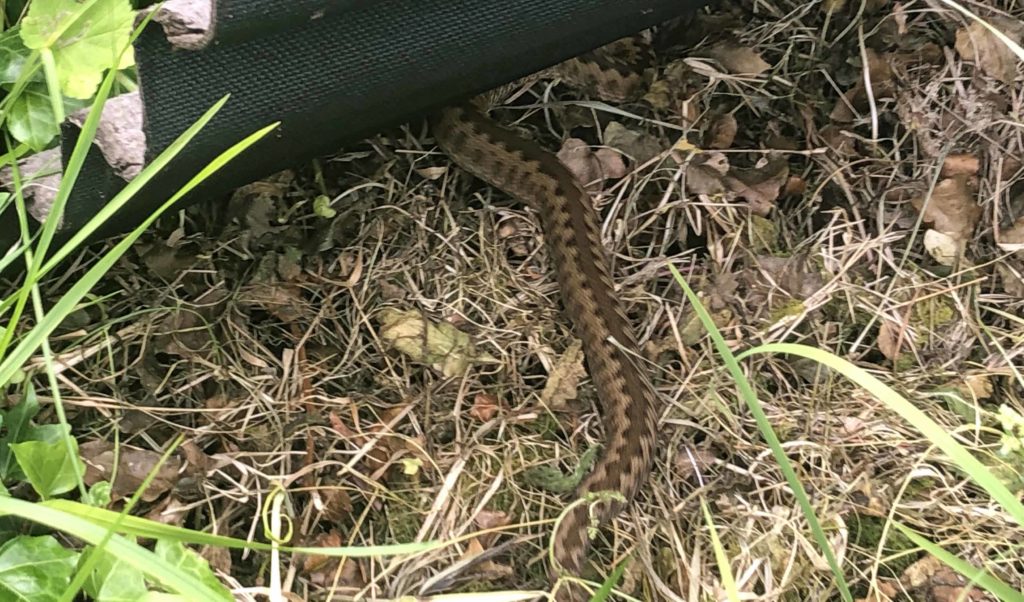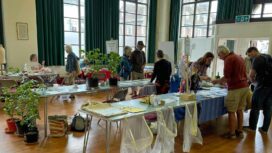An area of chalk meadow on the Glebe Estate in Studland, that was gifted to the National Trust in the 1990s by an eminent local who received a damehood for her contribution to science, may now be sold to developers.
Residents of the estate, which has far reaching views across Poole Harbour and where properties sell for more than a million pounds, are concerned that Clayton Meadow will become another building plot.

View over to Poole Harbour

The meadow is surrounded by housing and farmer’s fields but it’s believed that it’s never been disturbed or developed
Protected for centuries from farming or building
It’s claimed by locals that the land is a unique area of undisturbed hay meadow that has been protected for centuries from farming or building and is a haven for wildlife.
According to environmental campaigners, across the UK only two percent of the meadows that existed in the 1930s now remain. Led by the charity Plantlife, a national campaign has been set up called Save Our Magnificent Meadows.
It organises a National Meadows Day, an annual celebration of wildflower meadows across the UK, which in 2021, falls on Saturday 3rd July.


Wild orchids and adders can be found in the meadow
Gifted to the National Trust by Dame Barbara Clayton
The land was gifted to the National Trust by Dame Barbara Clayton in 1998, who owned a house on the Glebe Estate overlooking the meadow. At the time, there was an article about the acquisition in the National Trust’s Purbeck newsletter:
“An unusual gift of a house building plot on the Glebe Estate in Studland has been made to the National Trust by Dame Barbara Clayton. The Glebe Estate sits halfway up the Studland Hill and was sold by the church at the beginning of the century for development.
“At the time of the sale, the land would have been part of the extensive downland that formed Studland Hill and Ballard Down. Dame Barbara’s plot was never built on and ironically by being designated as a building plot was saved from being ploughed or agriculturally being improved.
“The vegetation has remained much as it was over one hundred years ago, and now it is a small time capsule showing what the Studland Hill and Ballard Down hay meadows must have once looked like.
“The Trust will manage the plot in the same way that Dame Barbara has, but will be collecting the seeds from the plot and scattering them over Ballard Down and Studland Hill in the hope of re-introducing the indigenous species…”
National Trust’s Purbeck newsletter – August 1998

The area of land is in the middle of the Glebe Estate in Studland. Similar plots with planning permission for redevelopment have been sold recently for more than a million pounds
Raised at Studland Parish Council
The issue of the potential sale of Clayton Meadow was raised by local residents at the Studland Parish Council on Monday 21st June 2021. In public participation time, Mike Neville who lives opposite the meadow requested the support of the parish council to ascertain the information that the National Trust held in relation to Dame Barbara’s gift. He said:
“It doesn’t affect the view from our house – not personally, but any change will impact other residents. We’d like to form an opinion based on facts – what were the provisions of the gift?”

Dame Barbara Clayton and the National Trust sign in the meadow
“She would be turning in her grave”
Another neighbour, Mike Cheesman said:
“I knew Dame Barbara very well – she would be turning in her grave if she knew that there were plans to sell the meadow. She trusted the National Trust to keep it safe for conservation.”
In a motion proposed by the chair, Nick Boulter, the parish council agreed to ask the National Trust to release documents relating to the gift, in the interests of transparency, before a decision on the future of Clayton Meadow was reached.
Speaking outside the meeting, Mike Cheesman added:
“The National Trust encourages people to leave gifts to them and as a conservation charity, people think they can trust the National Trust to do the right thing after they’ve gone.
“It’s a matter of principle – Dame Barbara entrusted the land to the NT because she wished the meadow to be preserved from being built on, so it could remain forever as an example of a hay meadow on chalk, a rare habitat. Does the NT really wish to destroy this wildlife meadow, as well as the trust of others considering similar bequests?”


A slow worm and other evidence of wildlife can be found in the meadow
“Now undertaking a full survey of the nature value of the site”
A spokesperson for the National Trust said:
‘A plot of land – equivalent to the size of about four tennis courts – at the Glebe Estate, Studland, was generously given to the National Trust by Dame Barbara Clayton in 1998 with conditions that we could sell the site for development if it no longer had nature conservation interest, and that the proceeds would be used to buy other chalk downland within the Isle of Purbeck, creating wider nature benefit and public access over a much greater area.
“We are now undertaking a full survey of the nature value of the site before any decisions are made about its future.”
Dame Barbara was no stranger to controversy
Dame Barbara was born in Liverpool in 1922 and went on to study medicine at Edinburgh University. For much of her career she was a professor of chemical pathology at Great Ormond Street Hospital.
As an academic, she published more than 200 research papers. Her work led to advances in hormone chemistry, improvements to the diet of children and older people and the prevention of lead pollution, advising the government to ban lead in food cans and paint.
In 1988 she was made DBE for services to medicine and, in 1999, was awarded the British Medical Association’s gold medal for distinguished merit.
Chaired the enquiry into the Camelford water contamination
Dame Barbara was no stranger to controversy. In 1989 she was asked to chair the enquiry into an incident in which the drinking water in Camelford in Cornwall was accidentally contaminated by a high concentration of aluminium sulphite.
As many sought to blame the water authority for their medical symptoms, they focussed their anger and frustration on Dame Barbara who received hate mail from some people.
She died in 2011, at the age of 88. In an obituary in The Guardian newspaper, it described Dame Barbara:
“She was a natural diplomat and leader, greeting colleagues with a hug, never raising her voice and dealing with ruffled feathers by inviting colleagues into her office for a cup of tea and a chat.
“Clayton was at once a very sociable person and a very private one, who loved her family, garden, dogs and the countryside.”

Further information
- More about National Meadows Day and the national campaign to protect wildlife meadows is on the Save Our Magnificent Meadows website
- When Dame Barbara Clayton died, obituaries were published by The Guardian and The Royal College of Physicians
- More about the work of The National Trust in Studland is available on its website





